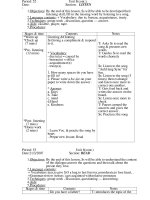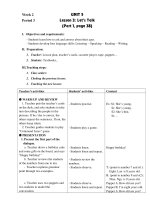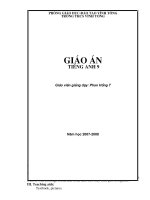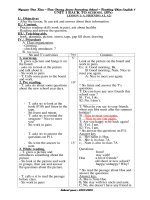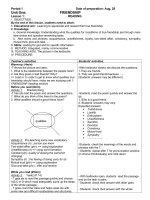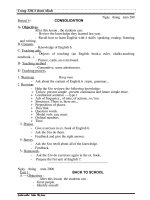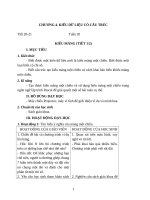Giao an TA 11(t1)
Bạn đang xem bản rút gọn của tài liệu. Xem và tải ngay bản đầy đủ của tài liệu tại đây (94.91 KB, 2 trang )
Period:1 Date of preparation: Aug, 28
Unit One: FRIENDSHIP
Lesson 1: READING
I. OBJECTIVES :
By the end of this lesson, students need to attain:
1. Educational aim: Learning to appreciate and respect their true friendship.
2. Knowledge:
a. General knowledge: Understanding what the qualities for /conditions of true friendship are through main-
idea-choice and question-answering tasks.
b. New words and phrases: acquaintance, unselfishness, loyalty, two-sided affair, constancy, sympathy,
mutual trust, give-and-take, ...
3. Skills: reading for gist and for specific information
II. METHOD: Integrated, mainly communicative
III. TEACHING AIDS: The picture in the textbooks
IV. PROCEDURE:
Teacher’s activities Students’ activities
Warm-up: (4min)
-T shows the picture and asks:
1. What is the relationship between the people here?
2. Are they good or bad friends? Why?
=> Lead in: In order to get to know what qualities true
friendship should have, today we are studying unit 1:
FRIENDSHIP (reading section)
Before you read (8min)
Activity 1: Brainstorming
-T has sts read the poem and answer the questions.
1. What do you think of the friend in the poem?
2. What qualities should a good friend have?
Activity 2: Pre-teaching some new vocabulary.
Acquaintance (n) : person you know
Two-sided affair (phr): => using explanation
Unselfishness (n) => using word formation
Constancy(n): quality of staying the same/not
changing
Sympathy (n) : the feeling of being sorry for sb
Mutual trust (phr) => using explanation
Give-and-take (phr) : offer and receive
While you read (25min)
Activity 3: Task2 (P.14)
- T gets sts to read the passage quickly and choose
A,B,C or D which most adequately sums up the ideas
of the whole passage.
- T goes round the class and helps weak sts with
some new and difficult vocabularies and structures.
-With textbooks closed, sts discuss the questions.
1.They are friends.
2. They are good friends because ......
(Students’ answers may be different.)
-Students read the poem quickly and answer the
qs.
1. S/he is a good friend.
2. Students’ answers may vary.
Expected answers:
• Truthfulness
• Loyalty
• Enthusiasm
• Unselfishness
• Sacrifice
• Devotion
• Constancy
• Mutual trust
• Sympathy
• .....................
-Students check the meanings of the words and
phrases with the T.
- Students repeat after T for pronunciation practice
(in chorusindividually) and note down.
- With textbooks open, students read the passage
and do the task in pairs.
- Students check their answer with other pairs.
- Students check their answer with the whole
qualities
- T makes sure that all sts understand the phrases.
- T may have sts explain their choice.
- T conducts correction.
Activity 4: Task3 (P.15)
- T helps students identify the key words and
understand all the questions.
1. What / first quality.
2. Why / incapable
3. What / third quality / what / tell
4. Why / mutual trust
5. Why / people / talk too much / not keep a friend
long.
6. What / last quality
- T asks the class to read the text again, this time
more carefully and more slowly, to answer the
questions.
- T has some students answer the questions in front
of the class.
- T observes and helps the class carry out correction.
- T gets feedback and gives correct answers
- T collects some pairs to ask and answer the Qs
aloud.
After you read (5min)
Activity 5:
- T has students work in groups of four to talk about
the qualities for true friendship.
Activity 6:
- T gets students discuss the question: “Why do we
need to have friends?”
- T may give some suggestions.
e.g. help, have confidence in, share feelings, …
- T makes comments and may give marks.
Homework assignment(1mn)
- T assigns students homework.
class.
=> Answer:
B. Conditions of true friendship.
- In pairs, sts find the key words and solve
difficulties.
- Students read the text again and answer the
questions.
- Students compare their answers with a partner.
- Students correct the wrong answers.
=> Suggested answers:
1. …. is unselfishness. It tells me that a person
who is concerned only with his own interests and
feelings cannot be a true friend.
2. …. because they take up an interest with an
enthusiasm, but they are soon tired of it and they
feel the attraction of sth new.
3. ….is loyalty. It tells me that the two friends must
be loyal to each other, and they must know each
other so well that there can be no suspicions
between them.
4. ….because if not, people cannot feel safe when
telling the other their most intimate secrets.
5. ….because they cannot keep a secret, either of
their own or others’.
6. ….is sympathy. It tells me that to be a true friend
you must sympathize with your friend.
- Students talk about the qualities for true
friendship.
- In groups, students have discussions. Then
representatives of the groups present their ideas in
front of the class.
=> Students’ answers may vary.
- At home, students do task 1(P.14) and write a
passage (120 words) about true friendship.
Comment : (1min)
